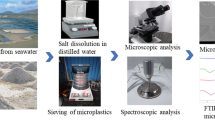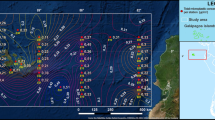Abstract
Microplastics in marine environments are of emerging concern due to their widespread distribution, their ingestion by various marine organisms, and their roles as a source and transfer vector of toxic chemicals. However, our understanding of their abundance and distribution characteristics in surface seawater (SSW) remains limited. We investigated microplastics in the surface microlayer (SML) and the SSW at 12 stations near-shore and offshore of the Korean west coast, Incheon/Kyeonggi region. Variation between stations, sampling media, and sampling methods were compared based on abundances, size distribution, and composition profiles of microsized synthetic polymer particles. The abundance of microplastics was greater in the SML (152,688 ± 92,384 particles/m3) than in SSW and showed a significant difference based on the sampling method for SSWs collected using a hand net (1602 ± 1274 particles/m3) and a zooplankton trawl net (0.19 ± 0.14 particles/m3). Ship paint particles (mostly alkyd resin polymer) accounted for the majority of microplastics detected in both SML and SSWs, and increased levels were observed around the voyage routes of large vessels. This indicates that polymers with marine-based origins become an important contributor to microplastics in coastal SSWs of this coastal region.




Similar content being viewed by others
References
Andrady AL (2011) Microplastics in the marine environment. Mar Pollut Bull 62:1596–1605
Barnes D, Galgani F, Thompson R, Barlaz M (2009) Accumulation and fragmentation of plastic debris in global environments. Philos Trans R Soc B 364:985–1998
Browne MA, Galloway T, Thompson R (2007) Microplastics—an emerging contaminant of potential concern? Integr Environ Assess Manag 3(4):559–561
Browne MA, Dissanayake A, Galloway TS, Lowe DM, Thompson RC (2008) Ingested microscopic plastic translocates to the circulatory system of the mussel, Mytilus edulis (L.). Environ Sci Technol 42:5026–5031
Chae D-H, Kim I-S, Song YK, Kim S, Kim S-K (2014) Development of analytical method for microplastics in seawater. J Korean Soc Oceanogr 19:88–98
Cole M, Lindeque P, Halsband C, Galloway TS (2011) Microplastics as contaminants in the marine environment: a review. Mar Pollut Bull 62:2588–2597
Collignon A, Hecq JH, Glagani F, Pierre VD, Collard F, Goffart A (2012) Neustonic microplastic and zooplankton in the North Western Mediterranean Sea. Mar Pollut Bull 64:861–864
Cunliffen M, Engel A, Frka S (2013) Sea surface microlayers: a unified physicochemical and biological perspective of the air-ocean interface. Prog Oceanogr 109:104–116
Derraik JGB (2002) The pollution of the marine environment by plastic debris: a review. Mar Pollut Bull 44:842–852
Doyle MJ, Watson W, Bowlin NM, Seavly SB (2011) Plastic particles in coastal pelagic ecosystems of the Northeast Pacific ocean. Mar Environ Res 71:41–52
Engler RE (2012) The complex interaction between marine debris and toxic chemicals in the ocean. Environ Sci Technol 46:12302–12315
Gade AL, Heiaas H, Lillicarp A, Hylland K (2012) Ecotoxicology of paint mixtures: comparison between measured and calculated toxicity. Sci Total Environ 435–436:526–540
Halden RU (2010) Plastics and public health. Annu Rev Public Health 31:179–194
Hamid DE, Blustein G, Deya M, Amo B, Romagnoli R (2011) The anticorrosive performance of zinc-free non-toxic pigment for paints. Mater Chem Phys 127:353–357
Heo NW, Hong SH, Han GM, Hong S, Lee J, Song YK et al (2013) Distribution of small plastic debris in cross-section and high strandline on Heungnam beach, South Korea. Ocean Sci J 48:225–233
Hidalgo-Ruz V, Gutow L, Thompson RC, Thiel M (2012) Microplastics in the marine environment: a review of the methods used for identification and quantification. Environ Sci Technol 46:3060–3075
Jang YC, Lee J, Hong S, Shim WJ, Kang D (2013) Development and priority setting of policy measures on Styrofoam buoy marine debris. J Korean Soc Mar Environ Energy 16:171–180
Kim I-S, Chae D-H, Kim S-K, Choi S, Woo S-B (2015) Factors influencing the spatial variation of microplastics on high-tidal coastal beaches in Korea. Arch. Environ. Contam. Toxicol. doi:10.1007/s00244-015-0155-6
Lattin GL, Moore CJ, Zellers AF, Moore SL, Weisberg SB (2004) A comparison of neustonic plastic and zooplankton at different depths near the southern California shore. Mar Pollut Bull 49:291–294
Law K, Morét-Ferguson S, Maximenko N, Proskurowski G, Peacock E, Hafner J et al (2010) Plastic accumulation in the North Atlantic Subtropical Gyre. Science 32:1185–1188
Lee J, Hong S, Song YK, Hong SH, Jang YC, Jang M et al (2013a) Relationships among the abundances of plastic debris in different size classes on beaches in South Korea. Mar Pollut Bull 77:349–354
Lee K-W, Shim WJ, Kwon OY, Kang J-H (2013b) Size-dependent effects of micro polystyrene particles in the marine copepod Tigriopus japonicus. Environ Sci Technol 47:11278–11283
Lin T, Hu Z, Zhang G, Li X, Xu W, Tang J et al (2008) Levels and mass burden of DDTs in sediments from fishing harbors: the importance of DDT-containing antifouling paints to the coastal environment of China. Environ Sci Technol 43:8033–8038
Mallick PK (1993) Fiber-reinforced composites materials, manufacturing, and design. Marcel Dekker, New York
Moore CJ (2008) Synthetic polymers in the marine environment: a rapidly increasing, long-term threat. Environ Res 108:131–139
Moore CJ, Moore SL, Leecaster MK, Weisberg SB (2001) A comparison of plastic and plankton in the North Pacific Central Gyre. Mar Pollut Bull 4:1297–1300
Moore CJ, Moore SL, Weisberg SB, Lattin GL, Zellers AF (2002) A comparison of neustonic plastic and zooplankton abundance in southern California’s coastal waters. Mar Pollut Bull 44:1035–1038
Moore CJ, Lattin GL, Zellers AF (2005) Density of plastic particles found in zooplankton trawls from coastal waters of California to the North Pacific Central Gyre. The Plastic Debris River to Sea Conference, Redondo Beach, California
Morf L, Taverna R, Daxbeck H, Smutny R (2003) Selected polybrominated flame retardants—PBDEs and TBBPA, vol 338., Environmental SeriesThe Swiss Agency for the Environment, Forests and Landscape, Berne
Norén F (2007) Small plastic particles in coastal Swedish waters. KIMO Sweden. www.n-research.se. Accessed 29 June 2015
Rani M, Shim WJ, Han GM, Jang M, Song YK, Hong SH (2014) Hexabromocyclododecane in polystyrene based consumer products: an evidence of unregulated use. Chemosphere 110:111–119
Rocha-Santos T, Duarte AC (2015) A critical overview of the analytical approaches to the occurrence, the fate and the behavior of microplastics in the environment. Trends Anal Chem 65:47–53
Shim WJ, Song YK, Hong SH, Jang M, Han GM (2014) Fragmentation of polyethylene, polypropylene and expanded polystyrene with an accelerated mechanical abrasion experiment. Abstract book of CMICRO International Workshop, Plouzane, pp 13–14
Shtykova L, Ostrovskii D, Jacobsson P, Nydén M (2006) Interaction between medotomidine and alkyd resins: NMR and FTIR investigation of antifouling marine paint model systems. J Appl Polym Sci 99:2797–2809
Song YK, Hong SH, Jang M, Kang J-H, Kwon O-Y, Han GM et al (2014a) Large accumulation of micro-sized synthetic polymer particles in the sea surface microlayer. Environ Sci Technol 48:9014–9021
Song YK, Hong SH, Jang M, Han GM, Rani M, Lee J et al (2014b) A comparison of microscopic and spectroscopic identification methods for analysis of microplastics in environmental samples. Mar Pollut Bull 93:202–209
Thompson RC (2006) Plastic debris in the marine environment: consequences and solution. In: Krause JC, Nordheim H, Bräger S (eds) Marine nature conservation in Europe. Federal Agency for Nature Conservation, Stralsund, pp 107–115
Thompson RC, Olsen Y, Mitchell RP, Davis A, Rowland SJ, John AWG et al (2004) Lost at sea: where is all the plastic? Science 304:838
Thompson RC, Swan SH, Moore CJ, vom Saal FS (2009) Our plastic age. Philos Trans R Soc Lond B 364:1973–1976
Van A, Rochman CM, Flores EM, Hill KL, Vargas E, Vargas SA et al (2012) Persistent organic pollutants in plastic marine debris found on beaches in San Diego, California. Chemosphere 86:258–263
Wright SL, Thompson RC, Galloway TS (2013) The physical impacts of microplastics on marine organisms: a review. Environ Pollut 178:483–492
Wurl O, Obbar JP (2004) A review of pollutants in the sea-surface microlayer (SML): a unique habitat for marine organisms. Mar Pollut Bull 48:1016–1030
Zhou F, Guo H, Hao Z (2007) Spatial distribution of heavy metals in Hong Kong’s marine sediments and their human impacts: a GIS-based chemometric approach. Mar Pollut Bull 54:1372–1384
Acknowledgments
This work was a part of the project titled Gyeonggi Sea Grant Program funded by the Ministry of Oceans and Fisheries. This work was also supported by Basic Science Research Program through the National Research Foundation of Korea (NRF) funded by the Ministry of Education (Grant No. NRF-2013R1A1A2012696).
Author information
Authors and Affiliations
Corresponding author
Electronic supplementary material
Below is the link to the electronic supplementary material.
Rights and permissions
About this article
Cite this article
Chae, DH., Kim, IS., Kim, SK. et al. Abundance and Distribution Characteristics of Microplastics in Surface Seawaters of the Incheon/Kyeonggi Coastal Region. Arch Environ Contam Toxicol 69, 269–278 (2015). https://doi.org/10.1007/s00244-015-0173-4
Received:
Accepted:
Published:
Issue Date:
DOI: https://doi.org/10.1007/s00244-015-0173-4




